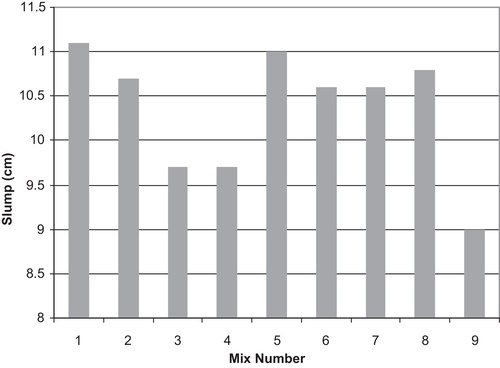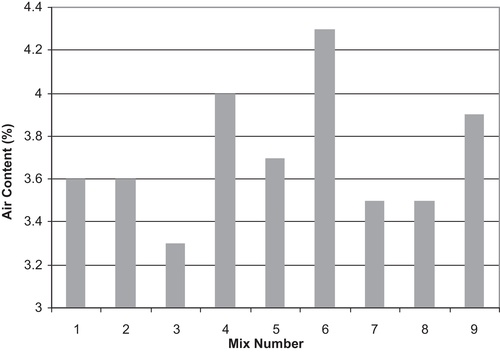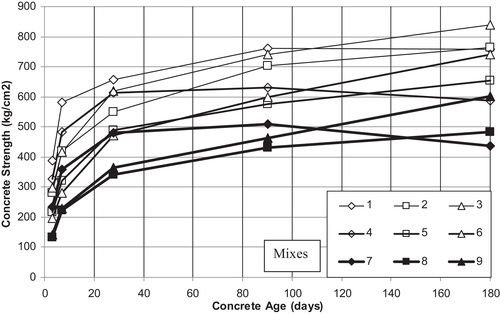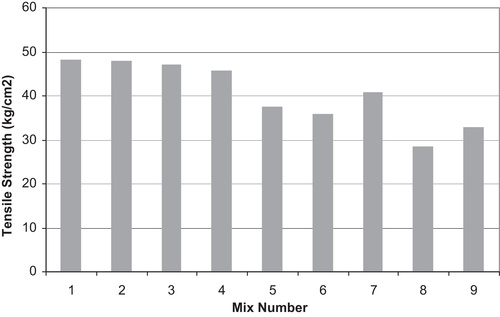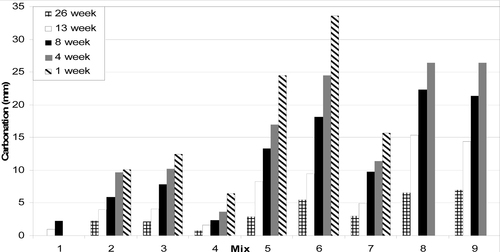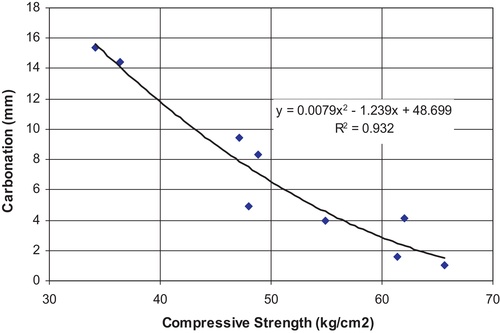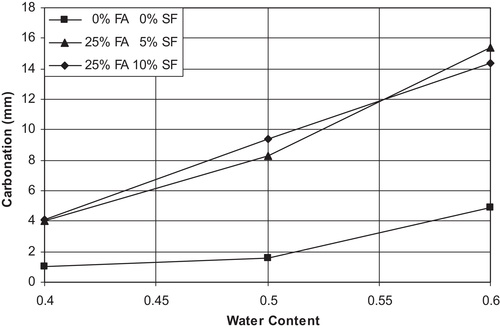Abstract
Carbonation is quite a complex physical negative effect phenomenon on concrete especially in the ones containing ternary blends of Portland Cement, fly ash, and silica fume. Nine selected concrete mixtures were prepared with various water to cementitious materials’ ratios and various cementitious contents. The concrete mixtures were adapted in such a way to have the same workability and air content. The fresh concrete properties were kept near identical in slump, air content, and unit weight. The variation was in the hardened concrete mechanical properties of compression and tension strength. The carbonation phenomenon was studied for these mixes showing at which mixes of ternary cementitious content heavy carbonation attacks maybe produced. The main components of such mixes that do affect the carbonation process with time were presented.
1 Introduction
Continuous generation of waste by-products possessing hydraulic and pozzolanic properties, create environmental problems, and outline the need for their greater utilization in different market sectors. CitationAntiohos et al. (2005) mentioned that the construction sector clearly absorbs the majority of such materials, by incorporating them in hydraulic binders as supplementary cementing materials. For a variety of reasons, the concrete construction industry is not sustainable. First, it consumes huge quantities of virgin materials. Second, the principal binder in concrete is Portland Cement, the production of which is a major contributor to greenhouse gas emissions that are implicated in global warming and climate change. Third, many concrete structures suffer from lack of durability, which has an adverse effect on the resource productivity of the industry. CitationMehta (2004) noted that the high-volume fly ash concrete system addresses all three sustainability issues, and its adoption will enable the concrete industry to become more sustainable.
In recent years, it has been reported that ternary blended cements could substantially improve the performance of concrete compared with conventional binary blended cements or regular Portland cement. Ternary blended cement consisting of Portland cement, granulated blast-furnace slag and fly ash (PC–SL–FA system) was developed in Japan for mass concrete construction due to its very low heat of hydration (CitationUchikawa and Okamura, 1993). This system can be treated as slag cement incorporating fly ash. The addition of fly ash can increase workability and reduce bleeding of slag cement concrete. CitationBerry (1980) found that strength development of this system is relatively slower at early age. CitationNehdi (2001) incorporated silica fume in slag cement or fly ash cement, the ternary PC–SL–SF (Portland Cement, blast-furnace slag and silica fume) and PC–FA–SF (Portland Cement, fly ash and silica fume) blended cements developed and commercially manufactured in Canada. More details about the properties of concrete containing Portland Cement, fly ash and silica fume as blended cements are mentioned in studies carried out by CitationAnwar et al. (2013). CitationAnwar and Roushdi (2014) showed improvements in concrete to resist environmental causes of deterioration.
Similar to the effect of silica fume addition in Portland Cement, the fluidity of PC–SL–SF system cement is impaired by silica fume. The addition of a water-reducing agent or a superplasticizer is inevitable for PC–SL–SF system cement. Fly ash in PC–FA–SF system may have water-reducing effect depending on its quality that may totally or partially compensate the increased water requirement caused by silica fume. When CitationPopovics (1993) incorporated 25% fly ash and up to 5% silica fume, he showed that flow of mortar had no significant change compared to ASTM Type I cement mortar. It was reported that addition of silica fume could only slightly increase the early strength of PC–FA–SF system cement. CitationRegourd et al. (1983) proved that strength did not increase much at either 28 days or more because Ca(OH)2 produced was preferentially consumed by the pozzolanic reaction of silica fume, thereby decreasing extensively the quantity of Ca(OH)2 available for the fly ash.
This paper studies the properties of ternary cementiting concrete systems. The measured properties included fresh concrete properties (slump, air content and unit weight) and hardened concrete properties, compressive strength and tensile strength. However, the major focus in this study is to observe the carbonation phenomenon as a durability reducer of such ternary cementitious systems and how it develops with time.
2 Experimental program outline
Several attempts have been carried out to allow Ordinary Portland Cement (OPC), Silica Fume (SF) and Fly Ash (FA) to work together. Nine concrete mixtures were prepared with water/cementitious material ratio of 0.4–0.6, cementitious content of 280–410 kg/m3 and sand/aggregate ratio of 0.40. The fly ash replacement was fixed at 25%, but the silica fume percentage varied between 5 and 10%. The used materials selected from commercial available construction materials follow the Japanese Industrial Standard (JIS), –.
Table 1 Mix proportions of the concrete mixtures (kg/m3).
Table 2 Properties of used Portland cement, silica fume and fly ash.
Table 3 Properties of used aggregates.
The materials were batched into the mixer according to the following sequence: coarse aggregate followed by sand, and then cementitious materials (OPC, FA, and SF were well mixed outside the mixer). The total mixing time was three minutes divided into two stages, starting with 60 s dry mixing, followed by the addition of the required water (mixed with chemical admixture) within 30 s, then the mixer continued for the next 1.5 min of wet mixing. After casting, the concrete molds were compacted by a vibrator. The samples were finished, stripped from their molds the day after casting. The specimens were cured in water until testing.
3 Measured concrete properties
3.1 Properties of fresh concrete
The measured properties of fresh concrete including slump are designed to achieve 10 ± 2 cm, with an air content of 4 ± 1%. Dosages of the used chemical admixtures (high performance superplasticizer and air entraining agent) on trial mixes were changed to fulfill the values mentioned above. During proportioning and mixing the concrete mixtures, it was noticed that fly ash mixtures need high dose of the air entraining agent to achieve the designed air content while silica fume mixtures need low dose of the air entraining agent. As for the superplasticizer, silica fume mixtures need higher dose than those of fly ash ones. The mixes including ternary systems of fly ash and silica fume showed that both silica fume and fly compensate each other regarding the dose of air entraining agent and superplasticizer. Results showed that the type of cementitious materials system plays a role in the produced fresh concrete.
The measured values of slump were within the designed range of 10 ± 2 cm, . The slump test results were nearly constant regardless of the variation in the mix proportions. There seems to be no specific trend for the shown mixes. The slump ranged from 9.0 cm to 11.1 cm. The measured values of air content were within the designed range of 4 ± 1%, , with a minimum of 3.3% and a maximum of 4.3%. The unit weight of these mixes was nearly constant. A value between 2.339 t/m3 and a maximum of 2.398 t/m3 is not considered a variation regardless of the cementitious material content.
3.2 Properties of hardened concrete
Compressive and tensile strength tests were performed. The compressive strength was measured at 3, 7, 28, 90 and 180 days, and . The tensile strength (cylinder of 15 cm diameter and height 30 cm) was measured at 28 days, . The compressive strengths of silica fume concrete in a ternary system are higher as silica fume percent increases, but all the ternary systems compressive strength are lower than the control mixes (1, 4 & 7) up to the studied 90 days age. After this age, the control mixes begin to lose some of their strengths, but the ternary systems continue to increase in compressive strength gain with slightly lower rates than that between the 28 and 90 days rate.
Table 4 Rate of compression strength gain as a ratio to 28 days strength for each mix.
The obtained results for the rates of compression strength gains are confirmed with CitationThomas et al. (1999) reporting that the combination of Portland Cement, silica fume and fly ash in a ternary cement system should result in a number of obvious synergistic effects. CitationLane and Ozyildirim (1999) indicated that the use of ternary blends incorporating small amounts of silica fume with smaller amounts of fly ash or slag showed a viable approach to counteract the negative impact of higher replacement levels of fly ash and slag on early compression strength gains. The obtained data show that binary cementitious blends of Portland Cement and silica fume offer significant advantages over plain Portland Cement. As for ternary cementitious systems, silica fume (5–10%), and fly ash (25%) indicate satisfactory compressive strength especially at ages of 28 and 90 days.
Direct comparison of the compressive strength values between mixes can be driven if the water/cementitious materials ratio, air content and slump of mixes are constant. However, a comparison of the results in and provides an indication of the contributions of FA and SF in the ternary blend. Higher portions of SF in the presence of certain FA percentages decreases the compression strength gain of concrete at early ages, but does increase in gain of compression strength beyond the 28 days far than that of the control mixes.
The 28 days tensile strength results () show similar trends as of compressive strength at 28 days due to the effect of using large replacement percent of FA. For high cementing content mixes, Mix 1 with no cement replacement shows the maximum tensile strength. Use of a combination of FA and SF with reasonable replacement percents in Mix 2 and 3 did not reduce the tensile strength much with respect to Mix 1. With cementitious content reduction, the effect of FA and SF is noticeable as a reduction in tensile strength of about 10% than that of the case of pure cement content mixes.
3.3 Carbonation effect
Carbonation is the process by which carbon dioxide (CO2) in the atmosphere reacts with water in concrete pores to form carbonic acid. The acid reacts with alkalines in the pores, neutralizing them. This reaction reduces the pH of concrete pore solution from 12.6 to less than 9. CitationNaik and Singh (1998) noted that the steel passive oxide film may be destroyed accelerating the start of uniform corrosion. On the contrary, the carbonation process seems to densify the concrete surface reducing surface porosity, to reduce chloride ion permeability (CitationMehta, 1994). CitationMaltais and Marchand (1997) showed that carbonation could have both positive and negative effects on concrete durability.
Carbonation is easily measured by spraying a phenolphthalein indicator on fresh concrete. The phenolphthalein solution will remain clear where concrete is carbonated and turn pink where concrete is still alkaline. CitationParrott (1987) showed that the best indicator solution for maximum contrast of the pink coloration is a solution of phenolphthalein in alcohol or water, usually 1 g indicator in 100 ml of alcohol/water (50:50 mix).
The carbonation process is not an exception for ternary concrete mixes where FA and SF may counteract each others advantages, . CitationGjorv (1983) and CitationVennesland and Gjorv (1986) reported as a result of silica fume incorporation in concrete, that the carbonation depths were only slightly reduced in ordinary concrete mixtures. However, this is counteracted in the existence of FA. Solely, the higher the FA content the higher is the carbonation process occurred. In addition, the higher is the Silica Fume added to the OPC and FA, the higher is the carbonation process than both the mixes of OPC only and OPC with FA. These findings are confirmed regardless of the age of concrete. The carbonation process increases with age. The rate of increase in carbonation is quite high with the higher cement content (mixes 1–3) and the rate decreases with the lower cement content (mixes 7–9). These rates are apparent in the normalized carbonation process shown in . The carbonation curves for any age were normalized with respect to the where the carbonation process at 28 days. The quantity of carbonation is not clear in such curve, but the rate of carbonation is apparent with respect to age and the type of mix. However, it seems that the carbonation process is inversely proportional to the concrete strength regardless of its cementitious content, .
Fig. 6 (a) Carbonation process in ternary concrete mixes with time (actual). (b) Carbonation process in ternary concrete mixes with time (normalized).
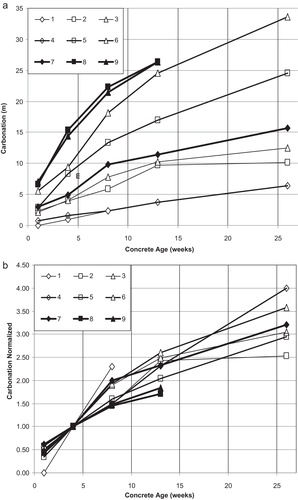
The carbonation rate is quite obvious when relating it to the water content ratio as shown in . In such behavior the contribution of the water content does increase the rate of carbonation. For the mixes with 0% FA and 0% SF, the increase would be 60% and 390% for the W-C of 0.5 and 0.6 respectively with respect to the W-C 0.4. For the set where there is 25% FA and 5% SF, the increase would be 108% and 285% for W-C 0.5 and 0.6 respectively with respect to the W-C 0.4. For the set where there is 25% FA and 10% SF, the increase would be 129% and 251% for W-C 0.5 and 0.6 with respect to the W-C 0.4, respectively. It is clear that the variation in the SF does not affect the increase in the carbonation rate much, while the percentage of FA does increase the carbonation rate considerably for the studied mixes.
For the W-C of 0.4 the carbonation rate increased by 300%, and 310% for the total cement content of 330 and 280 kg/m3 respectively with respect to the content of 410 kg/m3. For the W-C of 0.5, the carbonation rate increased by 419%, and 488% for the total cement content of 330 and 280 kg/m3 respectively with respect to the content of 410 kg/m3. As for the W-C of 0.6 the carbonation rate increased by 214%, and 194% for the total cement content of 330 and 280 kg/m3 with respect to the content of 410 kg/m3. It is obvious that the rate of increase in carbonation is not linear proportional with the total cement content.
4 Conclusion
Ternary systems concrete in the presented mixes do not show much contribution to the compressive strength of concrete. The FA content is more effective in changing the carbonation rate than that of the SF content. Short term carbonation process is inversely proportional to the concrete strength. Currently, tests are insufficient to establish the behavior of carbonation of ternary systems to concrete strength for extremely long time especially when such concretes may be attractive for application in massive structures. Ternary systems show higher carbonations than that of uni-cement systems.
Direct application in field for reducing the carbonation regardless of the cement content is required on the industry level to be established within a newly introduced specifications requirements. The carbonation testing is not easily and readily available in site, but maybe partially applied within research studies that would confirm the limits by which the carbonation limits would be acceptable.
Acknowledgement
The authors are grateful to Prof. Koji Sakai and the facilities within the Department of Safety Systems Construction Engineering, Kagawa University, Japan, for his kind assistance and financial support to prepare this paper. The authors would like to acknowledge the corporation of the Civil & Architectural Engineering Department, Shikoku Research Institute, Shikoku electric Power Company, Japan.
Notes
References
- S.AntiohosK.MaganariS.TsimasEvaluation of blends of high and low calcium fly ashes for use as supplementary cementing materialsCement Concrete Compos.2732005349356
- M.AnwarM.RoushdiImproved concrete properties to resist the saline water using environmental by-productWater Sci. J.201410.1016/j.wsj.2013.12.003
- M.AnwarM.RoushdiH.MustafaInvestigating the usage of environmental by-product materials in concrete for sustainable developmentAust. J. Basic Appl. Sci.792013132139
- E.E.BerryStrength development of some blended cement mortarsCement Concrete Res.1011980111
- O.E.GjorvDurability of concrete containing condensed silica fume, ACI SP-791983695
- D.S.LaneC.OzyildirimCombinations of Pozzolans and Ground, Granulated, Blast Furnace Slag for Durable Hydraulic Cement Concrete-Final Report1999Virginia Department of Transportation, University of VirginiaCharlottesville, Virginia, VTRC 00-R1
- Y.M.MaltaisJ.MarchandInfluence of curing temperature on cement hydration and mechanical strength development of Fly Ash MortarsCement Concrete Res.2771997365377
- P.K.MehtaMineral admixtures for concrete – an overview of recent developmentsM.W.GrutzeckS.L.SarkarAdvances in Cement and Concrete1994ASCENew York243256
- P.K.MehtaHigh-performance, high-volume fly ash concrete for sustainable developmentProceeding of the International Workshop on Sustainable Development and Concrete TechnologyBeijing2004314
- T.R.NaikS.S.SinghFly ash generation and utilization—an overviewA.K.SuriA.B.HarapanahalliRecent Trends in Fly Ash Utilization1998SOFEM PublisherNew Delhi, India125
- M.NehdiTernary and quaternary cements for sustainable developmentConcrete Int.23420013542
- L.J.ParrottA Review of Carbonation in Reinforced Concrete: A Review Carried Out by C&CA under a BRE Contract1987British Cement AssociationSlough, UK
- S.PopovicsPortland cement – fly ash – silica fume system in concreteAdv. Cement Based Mater.1219938391
- M.RegourdB.MortureuxH.HornainUse of condensed silica fume as filler in blended cementV.M.MalhotraProceedings of First CANMET/ACI International Conference on Use of Fly Ash, Silica Fume, Slag and Other Mineral By-Products in ConcreteMontebello, Canada, ACI SP-79, Farmington Hills, MI1983847865
- M.D.A.ThomasM.H.ShehataS.G.ShashiprakashD.S.HopkinsK.CailUse of ternary cementitious systems containing silica fume and fly ash in concreteCement Concrete Res.298199912071214
- H.UchikawaT.OkamuraBinary and ternary components blended cementS.L.SarkarMineral Additives in Cement and Concrete1993ABI Books PrivateNew Delhi, India179
- O.VenneslandO.E.GjorvSilica fume concrete-protection against corrosion of embedded steel, ACI SP-911986719

